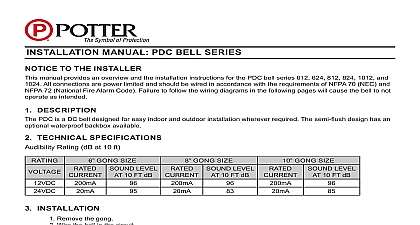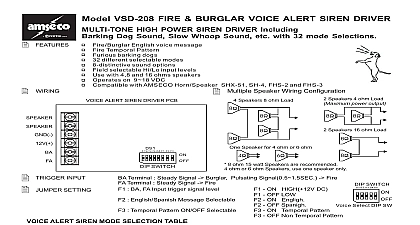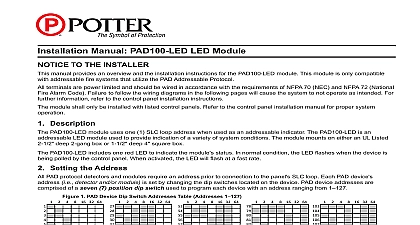Potter MSDS Information SEALED LEAD ACID BATTERY SERIES

File Preview
Click below to download for free
Click below to download for free
File Data
| Name | potter-msds-information-sealed-lead-acid-battery-series-0679358142.pdf |
|---|---|
| Type | |
| Size | 844.07 KB |
| Downloads |
Text Preview
MSDS Information LEAD ACID BATTERY SERIES Products Inc I Chemical Product and Company Identification Name Products Sealed Lead Acid Battery Series Products Inc Highway 70 West NC 28637 Identity Lead Acid Battery TLV mg m3 mg m3 mg m3 mg m3 mg m3 mg m3 mg m3 mg m3 wt or vol wt wt wt wt Name Electrode and Grid Pb Electrode Electrode II Hazardous Ingredients Identity Information Approximate OSHA PEL Oxide Sulfate Acid of components are dependent both on the model of the battery and the state of charge discharge of the battery Acid is reportable under Sections 302 311 312 and 313 of the Emergency Planning and Community Right To Act of 1986 EPCRA Reportable Quantity 500 lbs for sulfuric acid and 10,000 lbs for lead See Section XII 3 for more information Elk Products Sealed Lead Acid Batteries are a sealed non spillable design Under normal use and the customer has no contact with the internal components of the battery or the chemical hazards Under use and handling these batteries do not emit regulated or hazardous substances Warning Battery and related accessories contain lead and lead compounds chemicals known to the State of to cause cancer and reproductive harm Wash hands thoroughly after working with batteries and eating drinking or smoking III Physical Chemical Characteristics 110 112 11.7 mm Hg At 20 3.4 Lead Oxide and Lead Sulfate are insoluble in water Sulfuric Acid is 100 in water entire battery is a solid article consisting of an opaque plastic case with two lead terminals The battery is odorless Sulfuric Acid is a liquid 1.300 Point Pressure Density AIR 1 in Water Hazard Information Acute and Chronic Sulfuric Acid only International Agency for Research on Cancer IARC has classified inorganic acid mist containing sulfuric as a Category I carcinogen a substance that is carcinogenic to humans This classification does not apply to liquid of sulfuric acid or sulfuric acid solutions contained within the battery Inorganic acid mist sulfuric acid mist is not under normal use of this product Misuse of the product such as overcharging may however result in the of sulfuric acid mist of Entry Gravity H2O 1 and Odor inhalation mist skin and eyes ingestion destruction on contact May cause 2nd and 3rd degree burns or blindness will cause corrosive burns on contact May be fatal if swallowed of mists may cause upper respiratory irritation and burning of exposed tissues disorders may be aggravated by prolonged inhalation of mists and Symptoms Medical Conditions IV Emergency and First Aid Procedures Electrolyte to fresh air Give oxygen or artificial respiration if needed Get medical attention with plenty of water for at least 15 minutes Get immediate medical Contact 4 54 00 PM 1 of 5 Information LEAD ACID BATTERY SERIES Products Inc Contact contaminated clothing and flush affected areas with plenty of water for at 15 minutes not induce vomiting Dilute by giving large quantities of water If available several glasses of milk Do not give anything by mouth to an unconscious Give CPR if breathing has stopped Get immediate medical attention Applicable 4.10 Hydrogen gas Upper 74.20 chemical foam halon or CO2 V Fire and Explosion Hazard Data Point Limits Media Fire Fighting Procedures batteries are on charge turn off power Use positive pressure self contained breathing apparatus in fighting fire Water to electrolyte generates heat and causes it to splatter Wear acid resistant clothing Ventilate area well Fire and Explosion Hazards and oxygen gases are generated in cells during normal battery operation or when on charge Hydrogen is and oxygen supports combustion These gases enter the air through the vent caps during battery overcharging avoid risk of fire or explosion keep sparks and other sources of ignition away from the battery Do not allow metal to simultaneously contact both positive and negative terminal of batteries Ventilate area well VI Reactivity Data to Avoid under normal conditions and other sources of ignition Prolonged overcharge Fire or explosion due to possible hydrogen gas generation of sulfuric acid with combustibles and organic materials may cause and explosion Avoid strong reducing agents most metals carbides chlorates picrate Decomposition Products gas may be generated in an overcharged condition in fire at very high temperatures CO CO2 and sulfur oxides may emit in fire polymerization will not occur VII Precaution for Safe Handling and Use to be Taken in Case of Broken Battery Case or Electrolyte Leakage any electrolyte or exposed internal battery parts with sodium bicarbonate until fizzing stops Keep untrained away from electrolyte and broken battery Place broken battery and clean up materials in a plastic bag or non container Dispose of clean up materials as a hazardous waste Ventilate area as hydrogen gas may be given off neutralization Disposal Method and State laws prohibit the improper disposal of all lead acid batteries The battery end users owners are for their batteries from the date of purchase through their ultimate disposal The only legally method of disposal of lead acid batteries is to recycle them at a Resource Conservation and Recovery RCRA approved secondary lead smelter WASTE CODES D002 D008 to be Taken in Handling Storing and Transportaton in a cool dry area away from combustible materials Do not store in sealed unventilated areas Avoid overheating overcharging Precautions not charge in unventilated areas Do not use organic solvents or other than recommended chemical cleaners on battery VIII Control Measures Personal Protection room ventilation is sufficient during normal use and handling Recommend 2 to 3 room air changes per hour to Protective Equipment In the Event of Battery Case Breakage buildup of hydrogen gas 4 54 00 PM 2 of 5 Blue 3 Yellow 2 Information LEAD ACID BATTERY SERIES Products Inc wear safety glasses with side shields or full face shield rubber or neoprene gloves acid resistant boots apron or clothing Practices jewelry rings watches and any other metallic objects while working on batteries All tools should be adequately to avoid the possibility of shorting connections DO NOT lay tools on top of battery Be sure to discharge static from tools and individual person by touching a grounded surface in the vicinity of the batteries but away from Batteries are heavy Serious injury can result from improper lifting or installation DO NOT lift carry install or cells by lifting or pulling the terminal posts for safety reasons and because terminal posts and post seals may be DO NOT wear nylon clothes or overalls as they can create static electricity DO KEEP a fire extinguisher and communications device in the work area hands thoroughly after working with batteries and before eating drinking or smoking IX Regulatory Information Hazard Rating for Sulfuric Acid Red 0 X Transportation Information and proper Shipping Name Wet Non Spillable Electric Storage UN 2800 Unregulated meets the requirements of 49 CFR 173 159 d Unregulated meets the requirements of Special Provision A67 Unregulated all modes of transportation each battery and outer package must be labeled Battery This label must visible during transportation Batteries must be securely packed to prevent short circuiting XI California Proposition 65 Information State of California has determined that certain battery terminals contain lead and lead compounds


